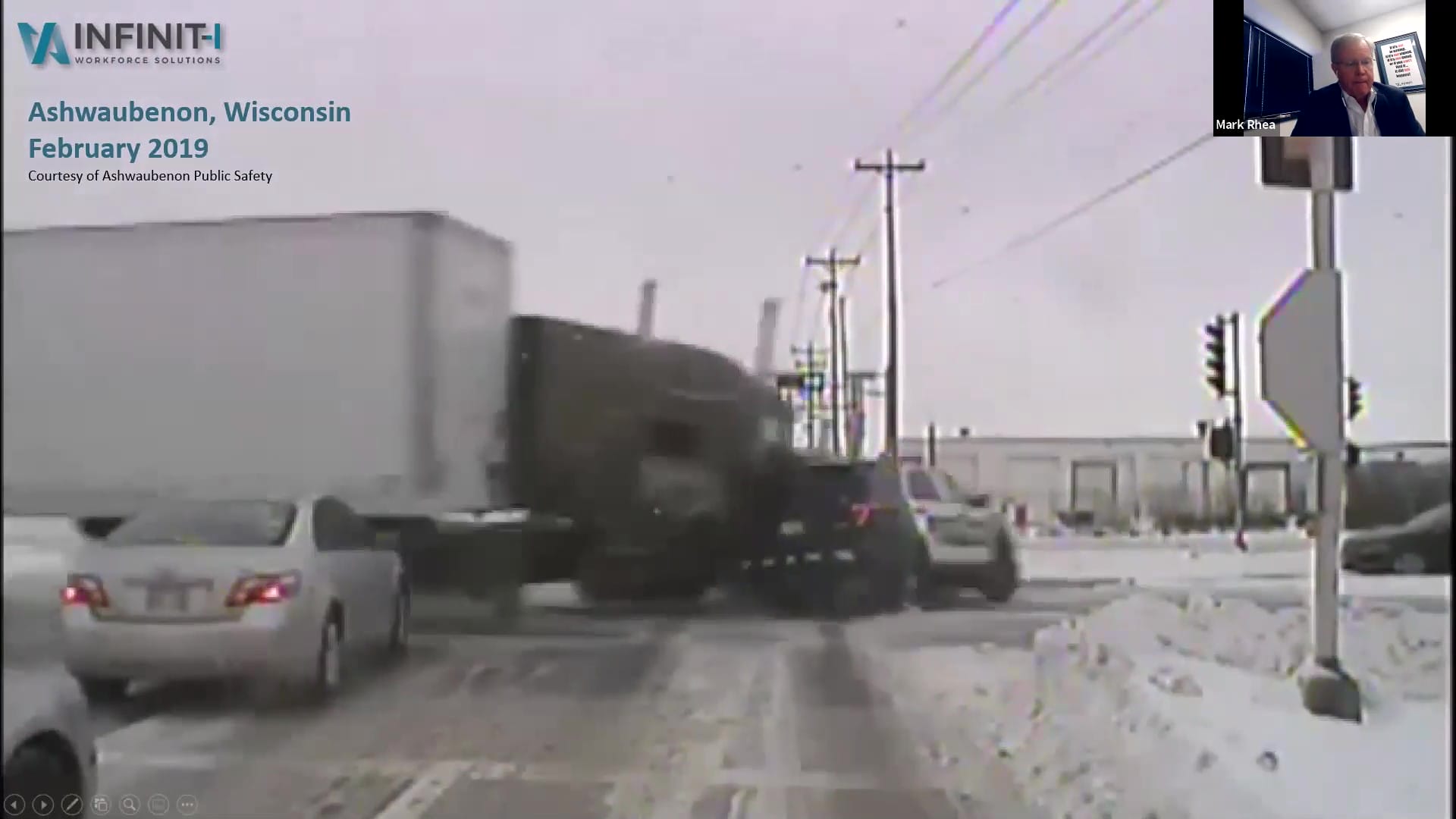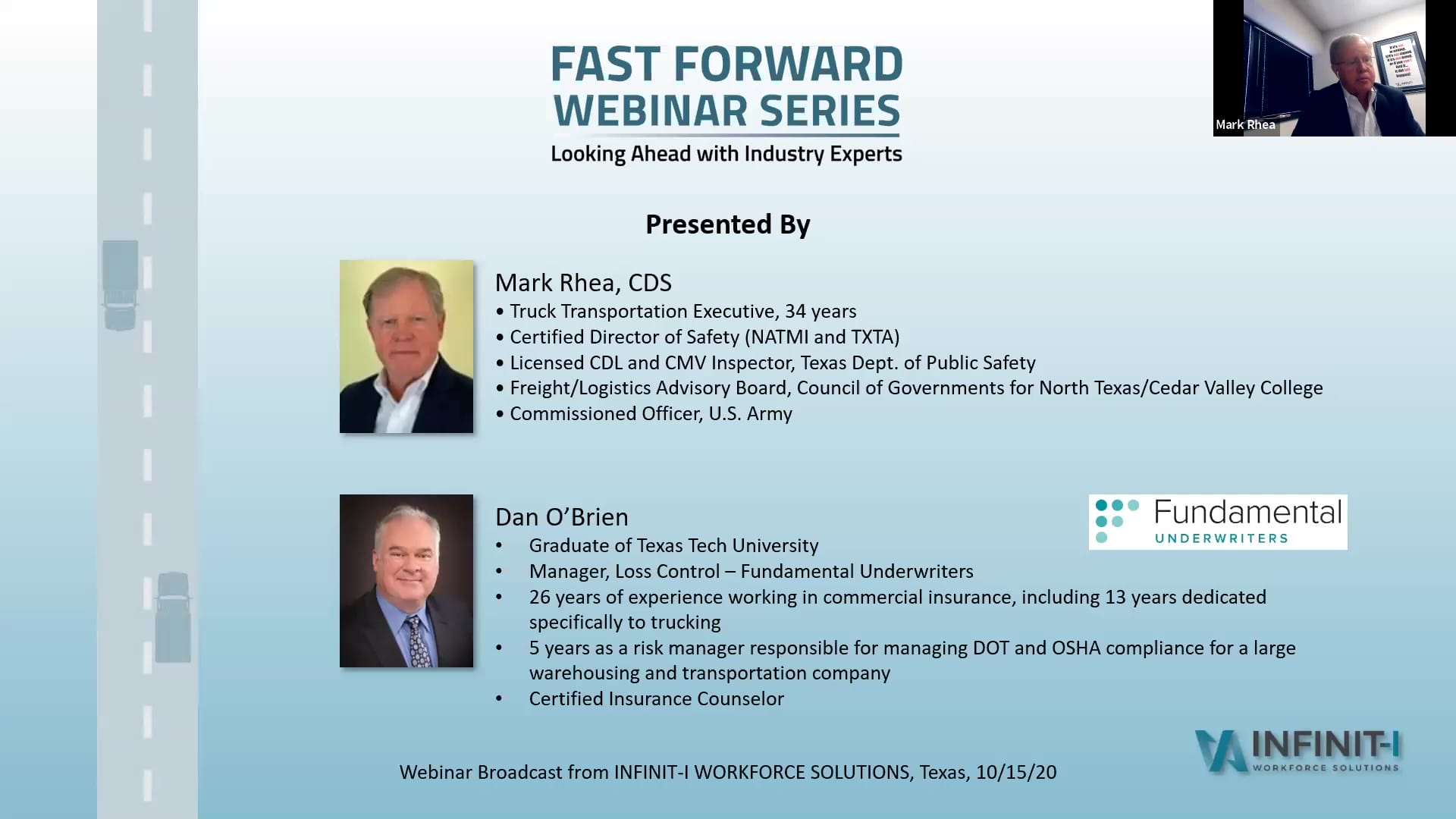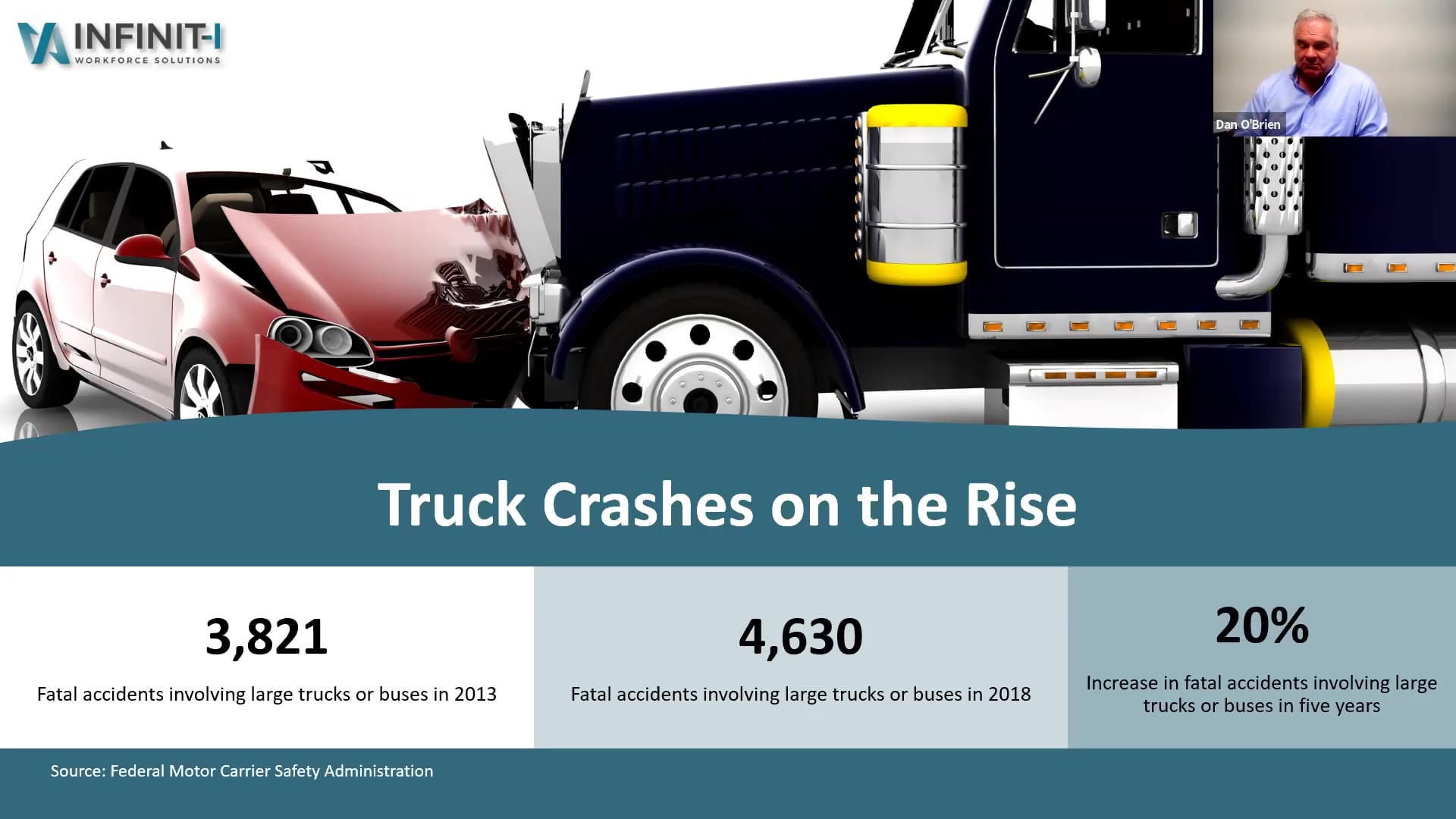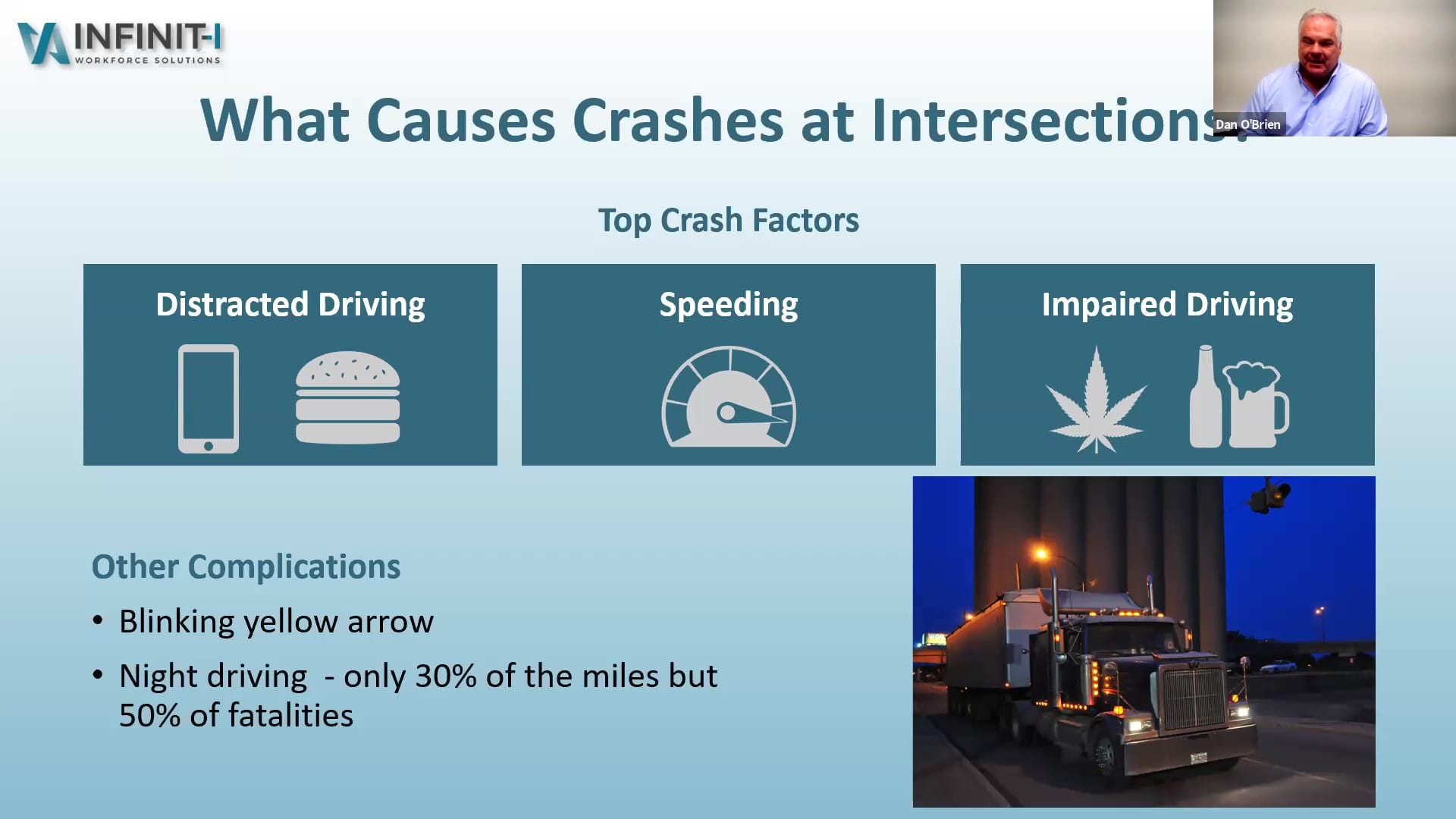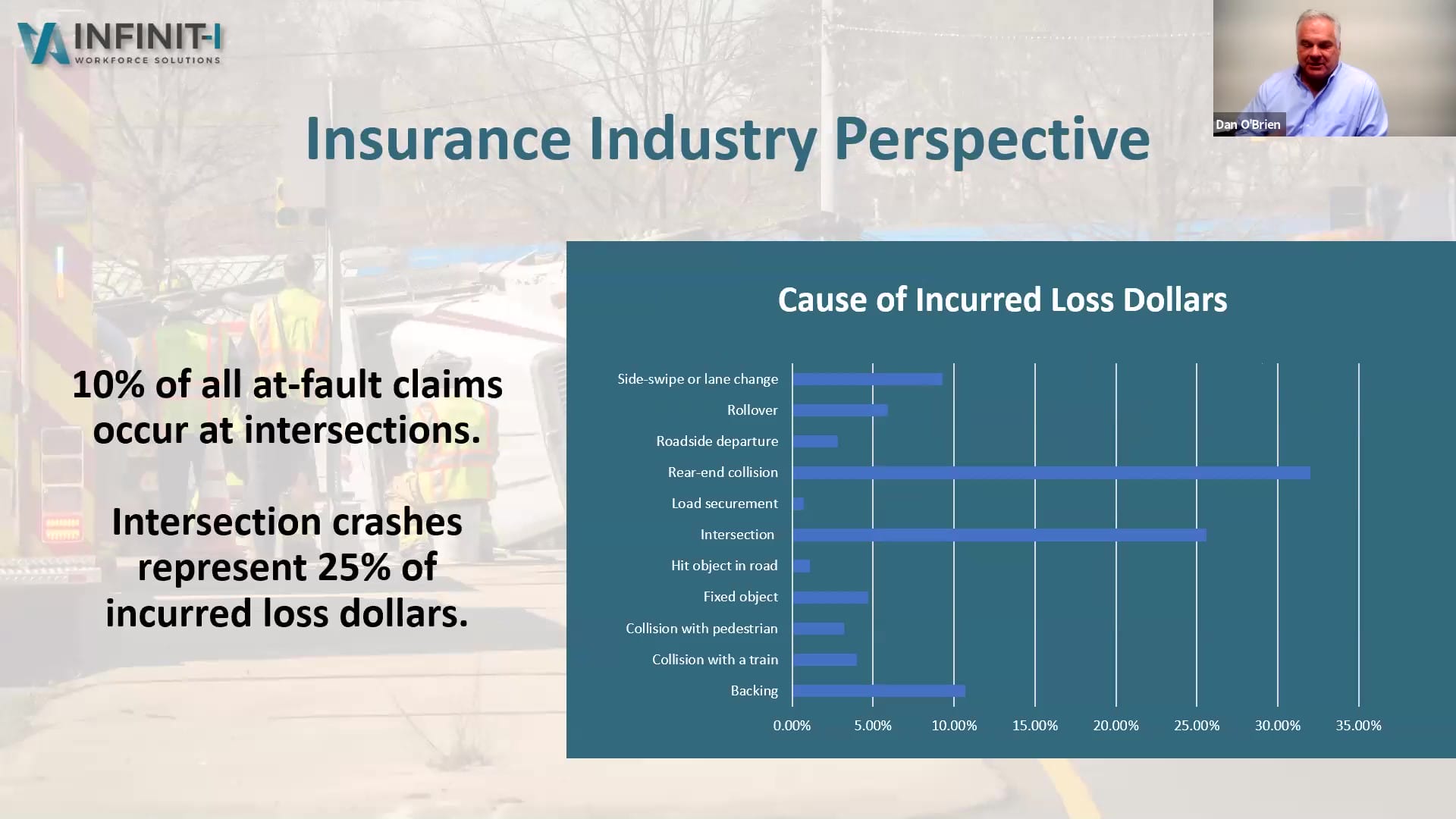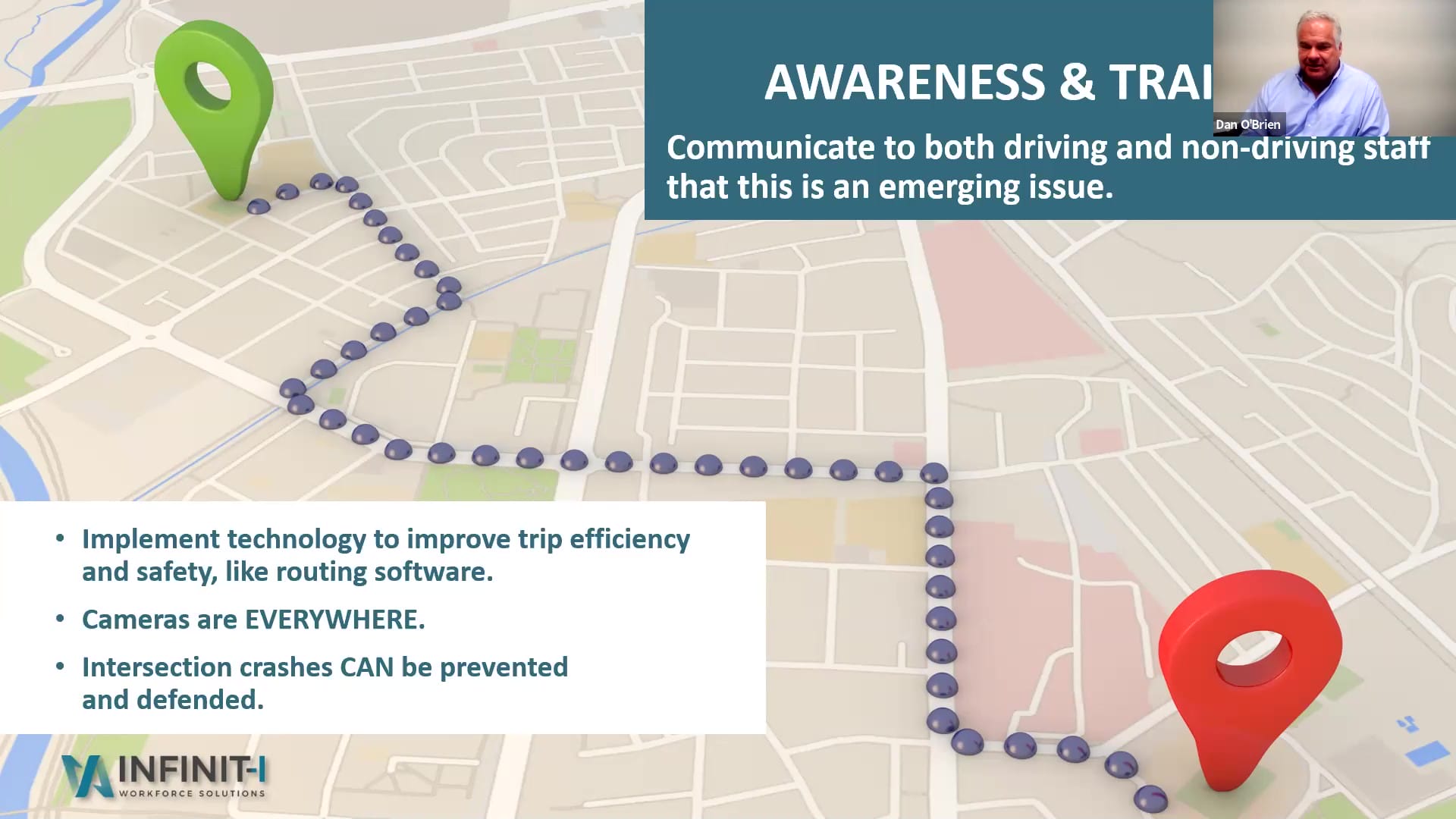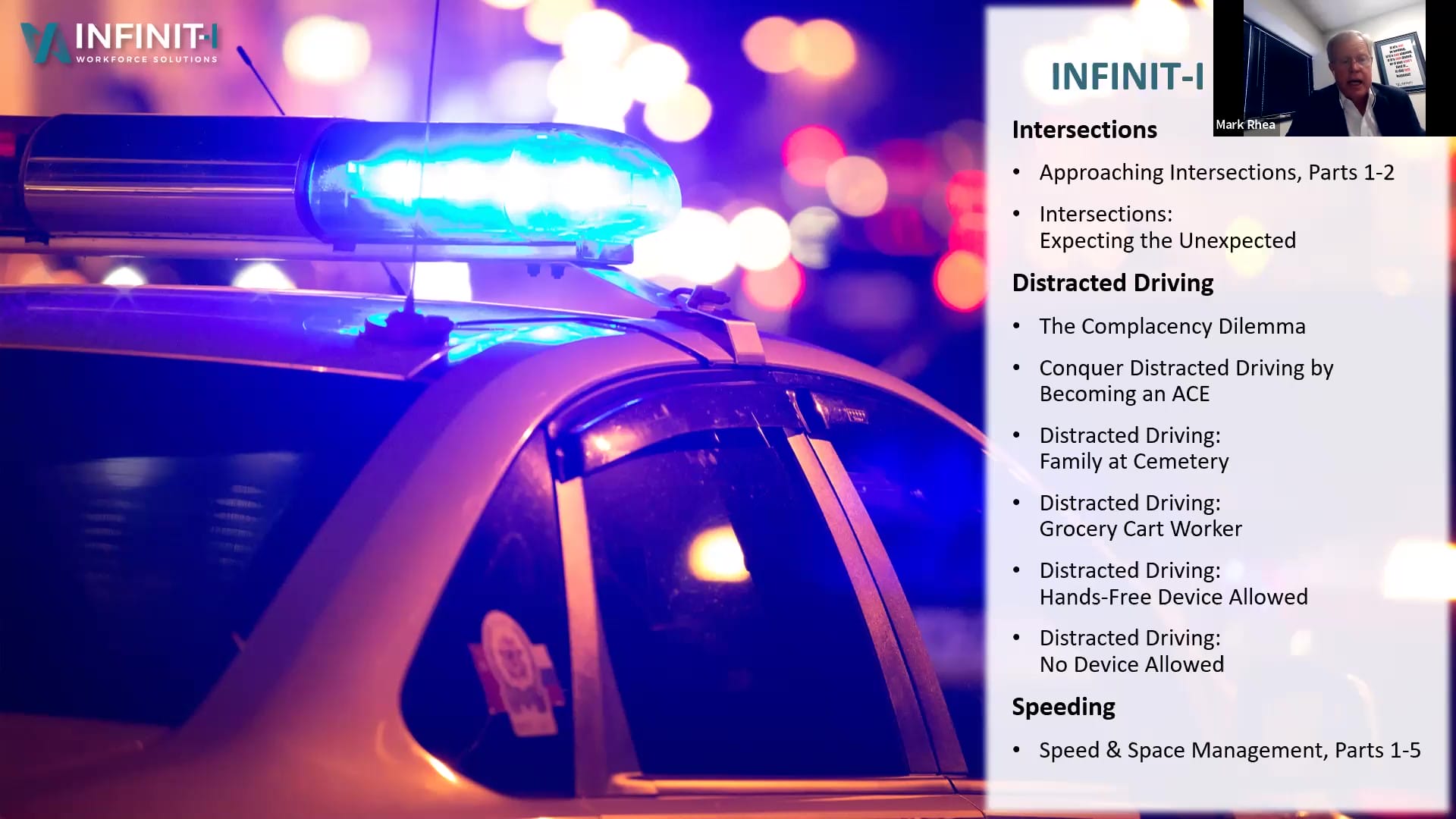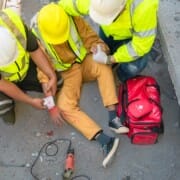Transcription
1
00:00:27.210 –> 00:00:37.740
Jay Wommack: Good morning, everybody. Jay Wommack founder and CEO of Infinit-I Workforce Solution. Thank you so much for joining us today. Our webinar will begin in just a few minutes appreciate y’all sitting on hold.
2
00:00:38.280 –> 00:00:43.560
Jay Wommack: While we’re here, waiting for everybody to jump on, I want to give a special shout out to our existing clients that are here with us today.
3
00:00:44.040 –> 00:00:50.790
Jay Wommack: You are proven to your entire workforce its safety is your number one concern is your number one priority. And we appreciate that because
4
00:00:51.090 –> 00:01:03.450
Jay Wommack: We’re very, very good at delivering training for safety orientation, for ongoing corrective action, and you obviously have taken the jump into the company right now and you’re using it, you’re, you’re saying that your
5
00:01:03.990 –> 00:01:09.630
Jay Wommack: People are valuable to you. And that’s exactly what we want. That’s what you want to people want to hear. So
6
00:01:10.170 –> 00:01:18.210
Jay Wommack: We do have all the answers. We know exactly what we’re doing a web-based training, we’ve doing this for 15 years, but I have a special offer today for our prospects that show up.
7
00:01:18.810 –> 00:01:30.690
Jay Wommack: We’d like to offer you a 30-day free trial using our system completely see what it’s all about. See if like using some like this, you know, remote training is jumped to the forefront.
8
00:01:31.170 –> 00:01:41.700
Jay Wommack: Of the world in the last 90 days, the world has shifted has changed remote training. We’re the experts we know more about remote training them virtually anybody in the entire I guess world, universe.
9
00:01:42.360 –> 00:01:49.080
Jay Wommack: So, I want to offer the 30-day free trial time offers women. Yeah, we can make this go on forever, which we could
10
00:01:50.160 –> 00:02:00.030
Jay Wommack: Throw in a CSR reps. Someone who a client service rep can make this thing hum for you get user activity up on the system because that’s the key. Get your people to use the system.
11
00:02:00.630 –> 00:02:08.550
Jay Wommack: I don’t care how many bells and whistles; you’ve got if they’re not going to use it. It’s not going to have an impact on your company. And at the end of the day, that’s what we’re all about.
12
00:02:09.000 –> 00:02:18.630
Jay Wommack: We want to see your top line and bottom line, improve, we won’t see your safety record improve. That’s what we do. And we do that better than anybody out there.
13
00:02:19.380 –> 00:02:26.190
Jay Wommack: Thanks for sticking with me. In the meantime, it’s what you came for us the webinar. So, Mark, if you’re ready. I will hand it over to you.
14
00:02:28.770 –> 00:02:39.270
Mark Rhea: Well, good morning, everyone. Thank you again. Jay, for that 30-day offer. I would strongly recommend that you go ahead and accept Jays offer
15
00:02:40.740 –> 00:02:41.730
Mark Rhea: Just as a quick
16
00:02:43.050 –> 00:02:56.670
Mark Rhea: Overview the, the potential to improve crash frequency of 20% is readily available, 80% reduction in violations, you can reduce training costs by 50%,
17
00:02:57.750 –> 00:03:07.020
Mark Rhea: So, if you just want to go ahead and accept Jays offer click yes here on this poll question, we’ll get right back with you.
18
00:03:08.340 –> 00:03:26.040
Mark Rhea: See a few yeses is coming in. That’s a good thing. So, the other thing of course documentation on lawsuits that we’re all day to day in everyone’s lives and the fact is remote training can save thousands of lives. So, I also want to make sure
19
00:03:27.060 –> 00:03:37.470
Mark Rhea: Jays commitment to our industry is unsurpassed I’ve known Jay’s 1999 we talked this morning and relived a few old stories of
20
00:03:38.250 –> 00:03:59.730
Mark Rhea: Back in the 90s, but his commitment to the industry is unsurpassed and we thank him very much for that. So today, let’s get on with our, our topic today is intersections. Expect the unexpected is clearly an emerging issue that we’re all
21
00:04:01.200 –> 00:04:19.980
Mark Rhea: need to be involved in, whether it’s training your, your driving staff your non driving staff, everybody. It’s clearly an emerging issue. We do have a quick dashcam to illustrate expect the unexpected and what can happen at an intersection. So, Colin, if you could show us that
22
00:04:36.990 –> 00:04:37.590
Mark Rhea: Whoops.
23
00:04:39.780 –> 00:04:48.360
Mark Rhea: That’s, that’s pretty self-explanatory, you’ve got you’ve got the green light you age out into the intersection and
24
00:04:48.900 –> 00:05:00.810
Mark Rhea: Get T-bone so that that’s the unexpected that can certainly happen at any given time to any of us, including our commercial trucks at intersections. So that’s just kind of set the tone.
25
00:05:01.140 –> 00:05:08.550
Mark Rhea: Of what we see on a regular basis today. My name is Mark Rhea. I’ve spent the last 35 years
26
00:05:09.120 –> 00:05:18.300
Mark Rhea: With Frozen Food Express here in Dallas, Texas, and I’ve seen and been involved in any number of intersection related crashes, T-bones, tail swings,
27
00:05:18.720 –> 00:05:26.340
Mark Rhea: squeezes, rear ends, you name it. They are real and they are now becoming an emerging issue.
28
00:05:26.760 –> 00:05:34.770
Mark Rhea: And I urge you to share the information that we cover today with your driving staff and your non driving staff to increase awareness.
29
00:05:35.460 –> 00:05:54.720
Mark Rhea: Expect the unexpected intersection related accidents can be prevented and I’m very proud to introduce our guest speaker today. Mr. Dan O’Brien from the insurance industry who sees the claims up close and personal
30
00:05:55.680 –> 00:06:04.290
Mark Rhea: not only from intersections but everywhere. But today, specifically, we’re going to talk about intersections. Mr. O’Brien is a native of West Texas
31
00:06:04.710 –> 00:06:26.880
Mark Rhea: spent the last 25 years in the insurance risk assessment and currently serves as loss control manager for fundamental underwriters he specializes in truck risk in insurance issues and as a certified insurance counselor. We’re very proud to have him today to
32
00:06:29.040 –> 00:06:37.470
Mark Rhea: Discuss what this emerging issue is, so if we can. Well, just to get started, Dan.
33
00:06:38.520 –> 00:06:41.100
Mark Rhea: Before we get into the formal presentation.
34
00:06:42.630 –> 00:06:55.980
Mark Rhea: As a loss control professional that represents the insurance industry side. I know you’ve seen a lot of trucking operations, some good, some maybe needing some TLC.
35
00:06:56.520 –> 00:07:19.620
Mark Rhea: And when you make an assessment and know you look at tangible things such as loss control, loss runs, equipment miles, driver NVRs. But my question is, do you consider culture or definability when you are making a risk assessment.
36
00:07:20.820 –> 00:07:21.540
Dan O’Brien: Absolutely.
37
00:07:22.920 –> 00:07:38.880
Dan O’Brien: Culture is primary. That’s one of the most important things we looked at as a part of their culture. Do they have mechanisms in place the controls in place to help us defend them. In other words, when you say dependability
38
00:07:40.140 –> 00:07:53.220
Dan O’Brien: When a claim that is mitigated the, the cost of that going is almost directly related to how well we can defend our customers. So, in other words,
39
00:07:54.030 –> 00:08:08.220
Dan O’Brien: Are they didn’t have proper training in place to the whole drivers accountable. Do they know kind of what’s going on. And because all those things you’re selling if a claim gets mitigated. If it’s bad enough, right.
40
00:08:09.390 –> 00:08:11.490
Dan O’Brien: The difference between
41
00:08:12.600 –> 00:08:29.880
Dan O’Brien: You know, claiming it’s over $50,000 could be a million dollar claim if if you had a driver that would have been involved in a car accident and got received more training, or more progressive discipline, corrective action. So, yes.
42
00:08:31.530 –> 00:08:43.560
Mark Rhea: It would be fair to say that not all intersection crashes are the critical factor and not always directed toward the commercial truck and if it’s not
43
00:08:44.310 –> 00:08:53.550
Mark Rhea: You got to be able to defend yourself and again I’m going back to that video. We just watched cop gets a green light pulls out there. Wham, and that wasn’t a commercial vehicle, but
44
00:08:55.530 –> 00:09:02.670
Mark Rhea: They certainly claim it’s his fault if he’s got some loose ends in these operations and a fair statement.
45
00:09:03.150 –> 00:09:05.850
Dan O’Brien: Absolutely waiting on the other side of the truck that when
46
00:09:06.930 –> 00:09:18.270
Dan O’Brien: You think about that. The driver of that truck. Let’s say he had been involved in similar accidents in the past and there had been no post-accident, no effort to
47
00:09:19.230 –> 00:09:31.110
Dan O’Brien: Help that driver or weed them out, you know, defense attorney, plaintiff attorney will basically say, you know, why is this guy still driving. What did you do to prevent this from happening. Yeah.
48
00:09:33.510 –> 00:09:43.950
Mark Rhea: That’s true. Okay, let’s go to the next one. Let’s talk a little bit more about intersection crashes, we can go to the next slide here crashes out of the out of the
49
00:09:45.090 –> 00:09:51.840
Mark Rhea: Universe of truck crashes. Today we want to zero in on intersections
50
00:09:53.430 –> 00:10:09.210
Mark Rhea: So, I’d like to ask you from a insurance claims point of view that sees the results that dollars to go out and claims. Do you see intersections crashes as an emerging issue.
51
00:10:10.290 –> 00:10:18.360
Dan O’Brien: Definitely. We’ve seen an increase in the number of intersection claims related to causes of accidents in total.
52
00:10:19.800 –> 00:10:35.370
Dan O’Brien: There’s been a up tip intersection types of claims. Some people may quantify and we call them failure to yield claims but what we really drill down we can see specifically that intersections are emerging
53
00:10:36.660 –> 00:10:37.200
Dan O’Brien: accident
54
00:10:38.220 –> 00:10:40.860
Dan O’Brien: Number, it’s very noticeable.
55
00:10:43.050 –> 00:10:58.890
Mark Rhea: What maybe we got a poll question here on this. I think we’ve got a poll question on awareness training for intersections. Yeah, here it is. Do you provide awareness training for intersections, yes or no, and if so, in what format.
56
00:11:01.110 –> 00:11:10.230
Mark Rhea: I guess the question I would have if it were an emerging issue is awareness training could potentially prevent
57
00:11:11.610 –> 00:11:13.200
Mark Rhea: certain the intersection crashes.
58
00:11:14.610 –> 00:11:15.960
Dan O’Brien: Yeah possibility
59
00:11:17.730 –> 00:11:24.000
Dan O’Brien: You know, I’m a firm believer, in driver training as a preventative measure to prevent accidents from happening.
60
00:11:25.980 –> 00:11:42.840
Dan O’Brien: It’s proven that trucking companies that provide top notch training, they can reduce the number of accidents and so I think if you have something specific for intersections. You can expect some improvement.
61
00:11:45.240 –> 00:11:46.080
Dan O’Brien: Absolutely is
62
00:11:47.370 –> 00:11:48.120
Dan O’Brien: Something I would recommend.
63
00:11:49.380 –> 00:12:07.860
Mark Rhea: So, so, just the fact if we can communicate to our professional drivers. When you approach an intersection, you get radars up. This is a danger zone. There’s, there’s all kinds of things going on with everybody coming and going from all angles, you need to you need to pay attention.
64
00:12:09.000 –> 00:12:12.210
Mark Rhea: Times to when you when you’re
65
00:12:13.470 –> 00:12:15.930
Mark Rhea: Navigating through an intersection
66
00:12:17.340 –> 00:12:24.240
Dan O’Brien: There so you’re searching or and you know everything’s you know documented with cameras everywhere. It’s
67
00:12:25.380 –> 00:12:26.250
Mark Rhea: Everywhere. Yeah.
68
00:12:26.310 –> 00:12:47.190
Dan O’Brien: Yeah, this is fraught with the potential problems, you know, yeah, people are they stopped too fast in front of you. People will pull out, you know, ignore there right away and then you know the factors that we can get into without distraction is that which is okay. There’s so much
69
00:12:48.390 –> 00:12:52.020
Dan O’Brien: potential problems when you enter an intersection. Right.
70
00:12:53.730 –> 00:12:58.440
Mark Rhea: Well, let’s look at it. Never. Most people are using online training is a good thing.
71
00:13:00.360 –> 00:13:06.960
Mark Rhea: Satellite messages. Nobody everybody’s doing some intersection awareness training.
72
00:13:08.880 –> 00:13:23.310
Mark Rhea: And of course, flyers and posters are good but online training those Dan do you want to comment on the most effective or maybe from an claim’s insurance point of view, what, you would recommend
73
00:13:23.760 –> 00:13:25.410
Dan O’Brien: Well, online training.
74
00:13:27.000 –> 00:13:29.460
Dan O’Brien: The latest technology is obviously going to better.
75
00:13:30.600 –> 00:13:41.910
Dan O’Brien: Online training, I think it’s more effective because, you know, especially if you have a way to document that training. If you have an opportunity to get it out to all your drivers and
76
00:13:42.540 –> 00:13:53.250
Dan O’Brien: You know, if you have multiple terminals or have drivers that are spread across the United States. It’s, it’s the most concise way to get your message out probably the best way to get training out.
77
00:13:54.600 –> 00:14:07.500
Dan O’Brien: You know what I’m saying, or I talked to a potential customer yesterday that only has two driver safety meetings a year. They do them in person and try to get all the drivers together, which is a chore.
78
00:14:09.240 –> 00:14:19.800
Dan O’Brien: But because of the pandemic. They haven’t been doing that. So basically, for the past eight months or nine months they provided no training to the drivers.
79
00:14:21.660 –> 00:14:23.220
Dan O’Brien: That’s not good and acceptable.
80
00:14:24.750 –> 00:14:29.520
Dan O’Brien: Accepted we were probably past will probably walk away from this opportunity.
81
00:14:31.890 –> 00:14:35.130
Dan O’Brien: And have online training and should be something they should consider.
82
00:14:37.440 –> 00:14:42.900
Mark Rhea: Gotcha. Okay, let’s go on to the next slide here on we’ve I think we’ve pretty much
83
00:14:44.610 –> 00:15:06.060
Mark Rhea: made the determination that if we can get the slide please. So, so the question if we could get. We got poll question close, please. Okay, let’s just keep going. So, questions. Why, what is triggering
84
00:15:07.830 –> 00:15:09.660
Mark Rhea: these
85
00:15:10.950 –> 00:15:15.840
Mark Rhea: intersection crashes as an emerging issue. You want to go into some of the things you’re seeing?
86
00:15:16.710 –> 00:15:28.140
Dan O’Brien: Well, you can see from the slide. I mean, the uptick the reason why we’re seeing more sessions is I think it’s mostly, you know, related to
87
00:15:28.740 –> 00:15:38.490
Dan O’Brien: distracted driving you know smartphones. Obviously, there are quite a while now, but I think people are becoming more and more addicted to them.
88
00:15:38.850 –> 00:15:54.180
Dan O’Brien: But there are all types of distraction. I see a hammer on slide there. People eating, looking at themselves in the mirror, but yeah. Distracted driving is I think probably related to the increase in this type of accident.
89
00:15:55.230 –> 00:16:00.750
Dan O’Brien: Some traditional factors or failure to control your speed as you enter and intersection.
90
00:16:01.950 –> 00:16:22.350
Dan O’Brien: Impaired driving and of course marijuana usage. That is probably to be honest with you. I don’t have any data to support this, but I believe there’s an increase in marijuana usage that probably could also be related to recent uptick intersection accidents.
91
00:16:24.540 –> 00:16:28.650
Mark Rhea: Yes, I can tell you there is an increase in
92
00:16:29.700 –> 00:16:37.260
Mark Rhea: Impaired driving and that certainly compound the problem. So, basically people aren’t paying attention.
93
00:16:38.520 –> 00:16:46.830
Mark Rhea: Other you know we got the commercial drivers, of course, but we also have the motoring public in.
94
00:16:47.880 –> 00:16:52.140
Mark Rhea: They’re distracted or not paying attention or impaired or all the above
95
00:16:53.070 –> 00:17:01.770
Mark Rhea: Absolutely. So as a commercial professional driver, you need to take that into consideration as you navigate through an intersection. It’s not me, it’s everybody else.
96
00:17:03.960 –> 00:17:05.490
Dan O’Brien: No doubt about it.
97
00:17:06.270 –> 00:17:17.550
Mark Rhea: Another complication. And I know there’s a lot of confusion on the blinking yellow arrow, not the blinking yellow, but the blinking yellow arrow.
98
00:17:19.590 –> 00:17:26.460
Mark Rhea: You want to comment on that as a new traffic control device. Yeah.
99
00:17:26.520 –> 00:17:32.490
Dan O’Brien: We were seeing more of those. Yeah, I think there’s a lot of confusion about maybe what it means.
100
00:17:35.550 –> 00:17:37.230
Dan O’Brien: That it’s something that
101
00:17:38.430 –> 00:17:41.760
Dan O’Brien: People would understand. I think it plays into the confusion.
102
00:17:42.780 –> 00:17:53.610
Dan O’Brien: As you enter an intersection like that. It’s a controlled intersection. You must, you have to be expecting the worst. And I think that gives people a false sense of security, sometimes
103
00:17:55.530 –> 00:18:02.790
Dan O’Brien: I noticed with night driving that is something if you look at that 30% of the miles.
104
00:18:03.750 –> 00:18:11.640
Dan O’Brien: Are done at night but 50% of the fatalities. That’s something that is an industry, we’re well aware of not time driving is
105
00:18:12.540 –> 00:18:29.040
Dan O’Brien: As much as we are, obviously, you know, it’s actually affecting the driver’s ability to see, obscured, it’s also the team driving often you see we see a lot of accidents occur at nighttime much disproportionately amount.
106
00:18:30.960 –> 00:18:35.670
Mark Rhea: So, all of these all of these contributing factors are things that we could
107
00:18:36.690 –> 00:18:45.150
Mark Rhea: Get out to our driving staff and our driver support staff through remote learning assignments. Is that, is that a fair statement.
108
00:18:45.600 –> 00:18:52.080
Dan O’Brien: Absolutely. And any one of the things intersections. There’s just hasn’t historically
109
00:18:53.340 –> 00:19:03.360
Dan O’Brien: As much material as you are saying specific allow specific stuff like distracted driving the one lane change accidents. We’re in schools like to have that
110
00:19:04.500 –> 00:19:08.880
Dan O’Brien: You’re just not as much out there about intersections
111
00:19:10.530 –> 00:19:10.920
Dan O’Brien: So,
112
00:19:12.930 –> 00:19:14.520
Dan O’Brien: It’s a great area to focus on.
113
00:19:17.760 –> 00:19:20.460
Mark Rhea: Let’s go to the next slide please.
114
00:19:23.280 –> 00:19:35.130
Mark Rhea: Well, well, let’s talk about the claim side of this, what are you saying relative to dollars and percentages of claims that are intersection related.
115
00:19:35.250 –> 00:19:48.600
Dan O’Brien: You know, this is our proprietary information. This is our specific data. But what we’ve seen in the last two years, we’ve paid out about $16 million in losses.
116
00:19:49.860 –> 00:20:00.180
Dan O’Brien: I was shocked. As I look through this that intersection accidents contribute to 10% total the numbers of those accidents and claims.
117
00:20:01.980 –> 00:20:15.690
Dan O’Brien: Which that’s a significant amount. That surprised me yeah think its a result of those things that we talked about distracted driving, impaired driving, those kinds of things are increasing that number.
118
00:20:16.710 –> 00:20:21.450
Dan O’Brien: But I think what was even more surprising to me and kind of more telling is that
119
00:20:22.470 –> 00:20:27.210
Dan O’Brien: You know that $16 million plus in insured losses that we’ve paid out
120
00:20:29.430 –> 00:20:34.110
Dan O’Brien: To about 25% of those dollars are for intersection accidents.
121
00:20:35.940 –> 00:20:50.370
Dan O’Brien: So, so what it tells you is that these claims are more expensive not only they’re increasing they’re more expensive, more dangerous, more likely to create a bodily injury.
122
00:20:51.480 –> 00:21:02.700
Dan O’Brien: And those are the kind of things that really impact your loss run, impacts your insurability if you will. Insurance companies look at a lot of things.
123
00:21:03.450 –> 00:21:12.270
Dan O’Brien: That your loss. Right. It’s, it’s, we’re looking at potential new customers is, it’s the first thing we look at, right. So, and look at the dollars they occur dollar
124
00:21:12.840 –> 00:21:31.890
Dan O’Brien: If you don’t know what incur dollars are that’s basically the paid losses and they expected final amount. In other words, pay cash reserves so interesting in a claim, you’ve got the pay dollars in the reserve dollars together, you know,
125
00:21:33.300 –> 00:21:38.520
Dan O’Brien: Or the army incurred last dollars and that’s what that’s what we look at so
126
00:21:39.780 –> 00:21:57.030
Dan O’Brien: Again, this, this, when I looked at this data. It’s just that jumped out at me because, again, a larger percentage of accidents occurred at intersections that I expected but end those Accenture just, you know, often more series of dangerous larger clients.
127
00:21:59.670 –> 00:22:08.190
Mark Rhea: Well, that’s, those, those are those are big numbers. And again, getting back to your earlier answer on culture. If you’re going in to do a risk assessment.
128
00:22:08.670 –> 00:22:24.210
Mark Rhea: On a renewal or maybe just deciding to write somebody insurance or not. And they are aware that intersection crashes are on the increase, and they represent 25% of claims.
129
00:22:25.320 –> 00:22:38.310
Mark Rhea: And what we’re doing about it is informing and training our drivers, I would think that would encourage you to look at this risk is as his manager. Is that a fair statement.
130
00:22:38.940 –> 00:22:53.340
Dan O’Brien: Absolutely, yeah. When I’m, you know, talking to a potential customer, but many of you guys out there probably into this experience you get a phone call or visit from the last one for consultant and then you go through the process.
131
00:22:55.380 –> 00:23:02.790
Dan O’Brien: A big component of that is drivers. Right. How do you know what he provides drivers, how you do it.
132
00:23:04.710 –> 00:23:08.250
Dan O’Brien: Is it is it organized. Do you keep your records.
133
00:23:09.420 –> 00:23:15.510
Dan O’Brien: Do you use it effectively. I mean, there’s usually three pieces that that driver training and onboarding
134
00:23:16.860 –> 00:23:17.730
Dan O’Brien: For new hires.
135
00:23:18.930 –> 00:23:19.500
Dan O’Brien: Then you’ve got
136
00:23:20.610 –> 00:23:26.190
Dan O’Brien: Just a regular Dr control that he can provide training for the least monthly.
137
00:23:27.780 –> 00:23:29.400
Dan O’Brien: The final piece of the post-accident.
138
00:23:30.690 –> 00:23:51.090
Dan O’Brien: That’s the thing cassettes from the really good, really good accounts from the less than houses are they providing training after the accident, are they providing training to drivers that have CSA violations, move your actions and most importantly accidents.
139
00:23:53.130 –> 00:23:57.330
Mark Rhea: So corrective action some in again with the
140
00:23:58.260 –> 00:24:03.780
Dan O’Brien: So documented proof that they’ve done something to try to correct that that they charge
141
00:24:06.630 –> 00:24:08.850
Mark Rhea: That that can be done. Can’t it
142
00:24:09.660 –> 00:24:10.710
Mark Rhea: Certainly, can be done.
143
00:24:10.710 –> 00:24:20.070
Mark Rhea: So, okay, let’s go to the next slide, then, now you’ve got me convinced that the danger zones are out there, and they’re called the intersections
144
00:24:20.610 –> 00:24:37.710
Mark Rhea: We’ve talked a little bit about awareness and training there. I know there’s a lot of technology cameras, you will, to provide any insight on technology routing software cameras and how that plays into the into the risk assessment.
145
00:24:38.340 –> 00:24:44.820
Dan O’Brien: Sure. I’m a big believer in music, whatever technologies out there that will help you
146
00:24:46.110 –> 00:24:51.600
Dan O’Brien: If you can’t have the ability to overlay certain intersections
147
00:24:55.830 –> 00:25:06.060
Dan O’Brien: Just notoriously bad and there’s studies out there which identify the worst intersections in America that data is out there.
148
00:25:07.260 –> 00:25:14.610
Dan O’Brien: If you can out your driver away from those intersections and I think that can be very effective.
149
00:25:15.750 –> 00:25:23.190
Dan O’Brien: Technology. Again, it touches all these different things. I see one of the GoPro cameras is effective.
150
00:25:24.810 –> 00:25:26.280
Dan O’Brien: We manage claims.
151
00:25:27.780 –> 00:25:35.880
Dan O’Brien: You, everything is documented. If you have a dashboard. Often, I think it’s a benefit. It helps you. It helps us
152
00:25:36.930 –> 00:25:46.650
Dan O’Brien: denied claims are congestion to the 90 787 to eight claims a month that they do not they will probably have to pay
153
00:25:47.580 –> 00:26:05.100
Dan O’Brien: The past so Technic anything that you can use in the whole realm of technology to avoid accidents to prepare your drivers for what’s coming ahead, and then also to to document is a positive
154
00:26:06.570 –> 00:26:24.570
Mark Rhea: Perspective. Okay, so yeah routing software that can minimize those left turns coming out of intersections is that less number of less of lecterns to take which can ultimately improve your, your loss ratios and all make sense to me.
155
00:26:25.980 –> 00:26:30.120
Mark Rhea: Intersection crashes can be prevented in definitive bottom line in
156
00:26:31.590 –> 00:26:33.690
Mark Rhea: awareness training is clearly where
157
00:26:34.740 –> 00:26:42.270
Mark Rhea: Where we need to go. Let me ask you this question. We’ve talked a lot about this as an emerging issue.
158
00:26:45.270 –> 00:26:48.300
Mark Rhea: defending a carrier
159
00:26:49.590 –> 00:27:03.450
Mark Rhea: What when you we talked about the defend ability and the culture. Are there any specific things that you look for or is it just your gut feelings when you have discussions with the management of trucking companies.
160
00:27:04.830 –> 00:27:18.240
Dan O’Brien: Well, you know that in their process, especially for trying to qualify new potential customers or an existing customer, you know we dig into all of the controls and look at
161
00:27:20.250 –> 00:27:31.290
Dan O’Brien: You know how they’re accountable accountability. The training the driver retention. Look at all that stuff, you know, overall culture is what we look for customers that
162
00:27:32.220 –> 00:27:42.900
Dan O’Brien: Were the ownership. The top management. So of course, they’re shaking department that is huge and what I am talking about support is
163
00:27:44.100 –> 00:27:56.610
Dan O’Brien: Finding and hiring good safety professionals and then giving them the tools that they need and probably the most important tool is driver training and
164
00:27:57.750 –> 00:28:06.690
Dan O’Brien: We love we love our customers that have Infinit-I. We’ve recently started trying to push them in that direction.
165
00:28:08.160 –> 00:28:09.840
Dan O’Brien: If they don’t have a training class one.
166
00:28:11.580 –> 00:28:23.100
Dan O’Brien: You know, just having the ability to provide training to all their drivers have a documented quantify it have an effective is paramount for us.
167
00:28:25.530 –> 00:28:28.950
Mark Rhea: Perfect. Well, let’s go to the next slide just
168
00:28:30.720 –> 00:28:41.130
Mark Rhea: So just, just to kind of a quick summary preparing accepting an understanding the dynamics of an intersection can certainly help
169
00:28:41.850 –> 00:28:53.730
Mark Rhea: Is needs to be a high priority and can certainly help in reducing those crashes. So, here’s we do Infinit-I has content immediately available.
170
00:28:54.570 –> 00:29:02.670
Mark Rhea: If you aren’t a client, you take Jay up on his 30-day offer will give you another offer to do that. You can get this
171
00:29:03.360 –> 00:29:14.370
Mark Rhea: Some of this content out to assign this afternoon approaching intersections expecting the unexpected, distracted driving speeding and space management.
172
00:29:15.060 –> 00:29:34.710
Mark Rhea: I won’t go into detail, but these this content is done, it’s effective and in which certainly help get the word out there of the dangers of at an intersection. So, I want to make sure that everybody understands. We do have that content immediately available.
173
00:29:36.480 –> 00:29:58.650
Mark Rhea: Let’s go to the next slide, please. This is just a quick overview of Japan. And while we’re looking at that slide. This is, you know, some of our customers. I wanted to, to review. One of the comments you made was about the number, the frequency of truck crashes and the percentage of dollars.
174
00:30:00.930 –> 00:30:15.600
Mark Rhea: That number again was 10% roughly of all truck crashes are intersection related. Now that’s the total population includes backing but 25% of the damages are in dollars. Is that, is that what I understood
175
00:30:16.020 –> 00:30:18.210
Dan O’Brien: You did. That’s, that’s, that’s our dad.
176
00:30:19.260 –> 00:30:30.570
Dan O’Brien: I think industry wide. It’s probably close to that. But what I can speak of this is, you know, over the last two years with over $60 million in incur losses.
177
00:30:31.590 –> 00:30:34.710
Dan O’Brien: 25% of those are related to intersections. Okay.
178
00:30:34.740 –> 00:30:40.740
Mark Rhea: So, so get it out there. The timing is right to get it out 30 or drivers.
179
00:30:42.120 –> 00:31:01.110
Mark Rhea: Distractions times to impairment, it’s speeding. It’s all of those contributing factors at intersection. So, we’ve got something to do, for all that, if you want to, to get that out. Here’s a poll question. Just, just check the yes not there.
180
00:31:03.450 –> 00:31:05.700
Mark Rhea: We’ll leave that up for just a minute.
181
00:31:07.170 –> 00:31:15.690
Dan O’Brien: And to your point, Mark earlier, you know, I’ve made the comment is Historically it’s been hard to find training materials that are related to
182
00:31:16.740 –> 00:31:22.740
Dan O’Brien: Intersections and you flashed up a lot of good training modules of training.
183
00:31:23.520 –> 00:31:33.690
Dan O’Brien: That could be directly related to intersections and stuff. It’s, it’s like distracted driving speeds-based management. Those are all important so
184
00:31:34.140 –> 00:31:44.610
Dan O’Brien: That’s impressive that you guys have that sex in a specific training because that’s another thing that we really like, and I know that this is this is the case for climate or litigated.
185
00:31:45.300 –> 00:31:54.390
Dan O’Brien: Is the more specific training. You can give with things like that, especially when we talk about the post-accident or aggressive. It is normally we get
186
00:31:55.710 –> 00:31:56.370
Dan O’Brien: Litigation
187
00:31:57.840 –> 00:32:12.570
Mark Rhea: Well, yeah. And the other thing I would like to think that some of the drivers that are engaged and accept that can also probably provide you with some Dash Cams have some close misses that that they’ve witnessed out there. There’s a
188
00:32:13.020 –> 00:32:18.780
Mark Rhea: There’s a lot of them, they’re close misses out there. So, it’s just crazy stuff that goes on with these intersections
189
00:32:19.140 –> 00:32:38.100
Mark Rhea: So, I talked to a driver and he now makes it a habit to count the number of people on their cell phones that he can see from this tab at an intersection. He says, usually at least 50% of the people immediately go to their cell phone when they get to a red light.
190
00:32:40.050 –> 00:32:50.850
Dan O’Brien: myself talking my son, the other day I knew he was driving. I was talking texting and I said, You’re, you’re driving right now and you’re texting me and he goes off, you’re not there.
191
00:32:51.420 –> 00:32:59.760
Dan O’Brien: Because I’m a stoplight. And that’s it. Put it away. You know, we know the industry. We know what happens. Now he
192
00:33:00.990 –> 00:33:10.680
Dan O’Brien: He may look out and see that thing alive is turned up still thinking about what’s going on text, it’s still a major distraction. Don’t care about your stock.
193
00:33:12.300 –> 00:33:16.530
Mark Rhea: Yes, in our, our plaintiff attorney friends know how to get that information. Don’t think
194
00:33:17.250 –> 00:33:18.540
Dan O’Brien: They do, again, it’s all
195
00:33:19.860 –> 00:33:33.690
Dan O’Brien: You know whether it’s a smartphone on camera. It’s, I guarantee you they can get yourself over records. And they were so it’s had a great impact on some of that nuclear vertex is the type of thing that makes a claim because you got to run.
196
00:33:34.200 –> 00:33:47.490
Mark Rhea: It takes us minor claim and turns it into a major coin. Now if we if you want to get a hold of Dan. Specifically, we do. We have another poll question. There’s his contact information.
197
00:33:50.040 –> 00:34:09.510
Mark Rhea: Well, I want to summarize that you’ve certainly convinced me that the intersections are dangerous, that we need to inform our driving staff and our non-driving staff of hazards intersections 25% of the dollars 10% of the of the crashes.
198
00:34:11.070 –> 00:34:25.140
Mark Rhea: That that’s straightforward to me. We’ve got a couple of questions. One of them is, can we get this information forwarded, which is, yes, we will get that to you in just a minute.
199
00:34:27.510 –> 00:34:31.650
Mark Rhea: Dan, I don’t have anything else. I certainly appreciate your insight.
200
00:34:32.700 –> 00:34:35.070
Mark Rhea: And your dedication to our industry.
201
00:34:37.050 –> 00:34:49.200
Mark Rhea: Before we go off. I know we talked a little bit about cameras and in what would what is from an insurance point of view. How do you view the usage of cameras for commercial truck.
202
00:34:50.130 –> 00:35:06.930
Dan O’Brien: It’s been a game changer. Probably one of the we talked about the smartphone or the negative side, one of the big challenges in this this whole thing that cameras have been from a positive standpoint, the biggest game changing
203
00:35:08.160 –> 00:35:09.090
Dan O’Brien: Quite a long time.
204
00:35:10.320 –> 00:35:14.580
Dan O’Brien: Again, I mentioned it earlier. We are denied claims.
205
00:35:16.890 –> 00:35:30.660
Dan O’Brien: Incredible rate that we used to just have them, he said. She said, cars, planes, and you know how if you understand how it works, the drivers of the troubles all are at fault. That’s the way to store for thought. We have been trying to overcome that.
206
00:35:31.920 –> 00:35:34.830
Dan O’Brien: Was quite difficult. Nothing is more effective than being able
207
00:35:36.060 –> 00:35:36.360
To
208
00:35:37.500 –> 00:35:48.630
Dan O’Brien: Show that claim show the driver of the little car coming into your life and cutting off. I mean, I look at these things over the scam videos on a monthly basis.
209
00:35:49.080 –> 00:36:04.470
Dan O’Brien: When we just are just nurses. They just are tickled to death to be able to say, now we’re close. When I get paid for this. So that’s been a game changer gather the driver facing cameras, you know, a lot of people were worried about those
210
00:36:05.700 –> 00:36:13.680
Dan O’Brien: We’re not finding that has a negative impact at all it’s really helping driver behavior modification
211
00:36:15.180 –> 00:36:27.600
Dan O’Brien: Drivers are less likely to be another phone do things that they shouldn’t do that. But also, there’s all kinds of new technology artificial intelligence.
212
00:36:28.170 –> 00:36:38.370
Dan O’Brien: There’s camera companies out there that do an extraordinary thing. So, I’m a big proponent of gamers. I think it’s the best thing that’s happened to our industry in a while.
213
00:36:39.360 –> 00:36:50.070
Mark Rhea: So, when we go back to that dependability cultural issue if you if you have a combination of online training with monthly assignments on current emerging issues such as intersections, such as
214
00:36:50.490 –> 00:37:04.770
Mark Rhea: fogs that just adverse weather in addition to a corrective action on triggering events that come from the camera. Your dependability of index goes up. Is that a. Is that a fair statement.
215
00:37:05.310 –> 00:37:08.580
Dan O’Brien: Absolutely, those two things together.
216
00:37:10.290 –> 00:37:15.750
Dan O’Brien: Are just so powerful. And when I talked to a potential customer that has got
217
00:37:16.860 –> 00:37:20.490
Dan O’Brien: Training with Infinit-I provides and a camera system.
218
00:37:21.630 –> 00:37:32.070
Dan O’Brien: They get both driver and rear facing cameras like Dr. Horton you’re facing cameras on the I’m just like, I’ve already pretty much a major, major decision.
219
00:37:33.480 –> 00:37:36.600
Dan O’Brien: It’s, it’s very important, those two things together are
220
00:37:37.770 –> 00:37:38.430
Dan O’Brien: Monumental
221
00:37:39.270 –> 00:37:54.030
Mark Rhea: Okay. Well, Dan. We want to thank you again for your, for your input from giving a perspective from the claims and risk insurance point of view, to help our listening audience maneuver through
222
00:37:55.230 –> 00:38:02.400
Mark Rhea: The world. They’re out there. And we do have a final dashcam to just further illustrate
223
00:38:02.910 –> 00:38:10.890
Mark Rhea: Expect the unexpected. You never know what’s going to happen, especially in an intersection and if it happens. You want to be able to defend yourself so
224
00:38:11.250 –> 00:38:22.140
Mark Rhea: Call it if you want to show us this last dash cam. I’m going to be signing off for today. Thank you again for everybody that listened in, Dan. Thank you very much, very much.
225
00:38:22.770 –> 00:38:23.670
Dan O’Brien: Thank you, more
226
00:38:23.700 –> 00:38:24.840
Dan O’Brien: Appreciate everybody listening.
227
00:38:25.110 –> 00:38:25.740
Mark Rhea: Yes, sir.
228
00:38:57.570 –> 00:39:01.290
Mark Rhea: Got expect the unexpected. Thank you again, we’ll be in touch.
229
00:39:01.890 –> 00:39:02.370
Thank you.
Infinit-I’s Top Takeaways
The webinar, hosted by Mark Rhea, focused on the emerging issue of intersection-related accidents and how to prevent them. The guest speaker was Dan O’Brien, a loss control manager for Fundamental Underwriters, who has extensive experience in the insurance risk assessment sector.
- Mark Rhea highlighted the potential dangers of intersections and showcased a dash cam video to illustrate the unexpected circumstances that often lead to accidents at these junctions.
- He stressed the importance of sharing the information covered in the webinar with both driving and non-driving staff to increase awareness about intersection-related accidents.
- Mark also introduced the guest speaker, Dan O’Brien, who is a specialist in truck risk and insurance issues.
- During the discussion, Mark asked Dan if he considers culture or definability when making a risk assessment, to which Dan confirmed he does.
In conclusion, the webinar emphasized the unexpected danger that intersections can present, particularly for commercial trucks. The message was clear: expect the unexpected and take preventive measures. The insights from Dan O’Brien further underscored the need for risk assessment and understanding the culture of trucking operations to mitigate these risks.
FAQs
What percentage of all truck crashes are intersection-related?
Approximately 10% of all truck crashes are intersection-related.
How much of the damages from truck crashes occur at intersections?
About 25% of the damages from truck crashes are intersection-related.
How can training help prevent intersection crashes?
Training can raise awareness about the dangers of intersections, help drivers expect the unexpected and equip them with strategies to navigate intersections safely.
What are some effective ways to train drivers about intersection safety?
Training modules on topics like approaching intersections, expecting the unexpected, distracted driving, speeding, and space management can be effective.
What role does technology play in intersection safety?
Technology like routing software can help to avoid dangerous intersections, and dash cams can provide valuable data for training and accident investigation.
How does distracted driving contribute to intersection crashes?
Distracted drivers may miss important visual cues or react slower, increasing the risk of crashes at intersections.
How can I use data to improve intersection safety?
Data from studies identifying dangerous intersections, as well as from your own fleet’s dash cams, can be used to inform training and route planning.
Is there specific training available for intersection safety?
Yes, there are training modules specifically designed to address intersection safety, including those that cover topics like approaching intersections and expecting the unexpected.
What is the role of corrective action in improving intersection safety?
Corrective action is key in addressing issues that lead to intersection crashes and preventing them from recurring.
How can I promote a culture of safety in relation to intersections?
Promote safety culture by providing regular training, encouraging open communication about safety issues, and holding all staff accountable for safety.
How does speeding contribute to intersection crashes?
Speeding reduces a driver’s ability to steer safely around curves or objects in the roadway, extends the distance necessary to stop a vehicle, and increases the distance a vehicle travels while the driver reacts to a dangerous situation.
What are some practices to avoid accidents at intersections?
Practices include reducing speed, being aware of blind spots, using signals, and being aware of other road users.
How does awareness training help in reducing intersection crashes?
Awareness training helps drivers recognize the hazards associated with intersections and how to navigate them safely.
How does space management training help in intersection safety?
Space management training helps drivers maintain a safe distance from other vehicles, reducing the chances of collision at an intersection.
How can I ensure that my drivers are following the intersection safety training?
Regular check-ins, observation, and feedback can help ensure that drivers are applying their training on the road.
How can intersection crashes impact my company?
Intersection crashes can lead to costly damages, injuries, increased insurance premiums, and potential reputational damage.
More Webinar Replays
TAT: Be a Changemaker Video
Preparing for Insurance Renewal: Webinar Replay Video #72
You might also like
Need Help?
Call Now
Sales: 972-232-7305
Support: 903-792-3866 x300
About
Free Resources
Benefits
- Reduce Motor Carrier Insurance Costs
- Accident Prevention Training and Legal Defense
- Regulations & Compliance
- Operations & Productivity
- Reduce Accident Costs by 50.7% Yearly
- Improve CSA Scores by 17-50%
- Reduce Accidents by 18%
- Reduce Driver Turnover up to 85%
- Improve Fuel Efficiency 3.5%+
- Reduce Training Costs by 50%
- Overages, Shortages and Damages
- Training Management System Benefits
- #1 Truck Driver Safety Training LMS

